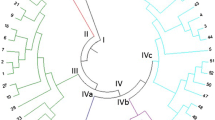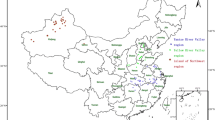Abstract
Fusarium semitectum is one of the important causal agents of dry rot of potato tubers in the world. In order to determine genetic variability among 41 isolates of F. semitectum, morphological and molecular studies were carried out. All F. semitectum isolates were recovered from infected potato tubers with dry rot symptoms collected from four provinces in Iran. According to macroscopic and microscopic characteristics, 41 isolates of F. semitectum were classified in two morphotypes (morphotypes I and II). All 41 isolates were evaluated for their pathogenicity on healthy potato tubers. Tuber rot symptoms were observed on the 21st day after inoculation of Fusarium isolates on the tubers tested. The measurement was done by comparing the depth and width of lesion expansion among the isolates. Molecular characterization through PCR-IGS-RFLP analysis by six restriction enzymes (AluI, BsuRI, Eco88I, MspI, TaqI and PstI) divided the 41 isolates of F. semitectum into two separated clusters that were in accordance with the morphological characterization.







Similar content being viewed by others
References
Alves-Santos FM, Martinez-Bermejo D, Rodriguez-Molina MC, Diez JJ (2007) Cultural characteristics, pathogenicity and genetic diversity of Fusarium oxysporum isolates from tobacco fields in Spain. Physiol Mol Plant Pathol 71:26–32
Appel DJ, Gordon TR (1995) Intraspecific variation within populations of Fusarium oxysporum based on analysis of the intergenic spacer region of the rDNA. Exp Mycol 19:120–128
Berbee ML, Taylor JW (1992) Two ancomycete classes based on fruiting-body characters and ribosomal DNA sequence. Mol Biol Evol 9:278–284
Berkeley MJ (1875) Notices of the North American fungi. Grevillea 3:97–112
Booth C (1971) The genus Fusarium. Commonwealth Mycological Institute, Kew, 237pp
Carnegie SF, Ruthven AD, Lindsay DA, Hall TD (1990) Effects of fungicides applied to seed potato tubers at harvest or after grading on fungal storage diseases and plant development. Ann Appl Biol 116:61–72
Chehri K, Ghasempour HR, Karimi N (2014) Molecular phylogenetic and pathogenetic characterization of Fusarium solani species complex (FSSC), the cause of dry rot on potato in Iran. Microb Pathog 67–68:14–19
Chelkowski J (1989) Toxinogenic of Fusarium species causing dry rot of potato tubers. In: Chelkowski J (ed) Fusarium mycotoxin, taxonomy and pathogenicity. Elsevier Publishing Co., New York, pp 435–440
Ebadi M, Riahi H, Zare R (2013) Genetic diversity of Fusarium semitectum isolates from rice, using RAPD and REP-PCR markers. Mycologia Iranica 1(1):14–20
Fisher NL, Burgess LW, Toussoun TA, Nelson PE (1982) Carnation leaves as a substrate and for preserving cultures of Fusarium species. Phytopathology 72:151–153
Gerlach W, Nirenberg H (1982) The genus Fusarium—a pictorial atlas. Mitt Biol Bundesanst Land Forstwirtsch Berlin Dahlem 209:1–406
Hawa MM, Salleh B, Latiffah Z (2010) Characterization and intraspecific variation of Fusarium semitectum (Berkeley and Ravenel) associated with red-fleshed dragon fruit (Hylocereus polyrhizus [Weber] Britton and Rose) in Malaysia. Afr J Biotechnol 9:273–284
Joffe AZ (1974) A modern system of Fusarium taxonomy. Mycopathologia 53:201–228
Jurado M, Vazquez C, Patino B, Gonzalez-Jaen MT (2005) PCR detection assays for the trichothecene-producing species Fusarium graminearum, Fusarium culmorum, Fusarium poae, Fusarium equiseti and Fusarium sporotrichioides. Syst Appl Microbiol 28:562–568
Leslie JF, Summerell BA (2006) The Fusarium laboratory manual. Blackwell Publishing Ltd., UK, 388pp
Lui LH, Kushalappa AC (2002) Response surface models to predict potato tuber infection by Fusarium sambucinum from duration of wetness and temperature, and dry rot lesion expansion from storage time and temperature. Int J Food Microbiol 76:19–25
Nash SN, Snyder WC (1962) Quantitative estimations by plate counts of propagules of the bean rot Fusarium in field soils. Phytopathology 73:458–462
Nelson PE, Toussoun TA, Marasas WFO (1983) Fusarium species: an illustrated manual for identification. Pennsylvania State University Press, University Park, 193pp
Patino B, Mirete S, Vazquez C, Jimenez M, Rodriguez MT, Gonzalez-Jaen MT (2006) Characterization of Fusarium verticillioides strains by PCR-RFLP analysis of the intergenic spacer region of the rDNA. J Sci Food Agric 86:429–435
Rohlf FJ (2000) NTSYS-pc numerical taxonomy and multivariate analysis system, version 2.1. Exeter Publishing Limited, Setauket, 38pp
Romesburg HC (1984) Cluster analysis for researchers. Lifetime Learning Publications, Belmont, 334pp
Secor GA, Salas B (2001) Fusarium dry rot and Fusarium wilt. In: Stevenson WR et al (eds) Compendium of potato diseases, 2nd edn. APS Press, St Paul, pp 23–25
Slininger PJ, Burkhead KD, Schisler DA (2004) Antifungal and sprout regulatory bioactivities of phenylacetic acid, indole-3-acetic acid and tyrosol isolated from the potato dry rot suppressive bacterium Enterobacter cloacae S11:T:07. J Ind Microbiol Biotechnol 31:517–524
Stevenson WR, Loria R, Franc GD, Weingartner DP (2001) Compendium of structure and genetic analysis of field resistance to thiabendazole in Gibberella pulicaris from potato tubers. Phytopathology 83:164–170
Venter SL, Steyn PJ (1998) Correlation between fusaric acid production and virulence of isolates of Fusarium oxysporum that causes potato dry rot in South Africa. Potato Res 41:289–294
Wollenweber HW, Reinking OA (1935) Die Fusarien. Ihre Beschreibung, Schadwirkung und Bekämpfung. Verlag Paul Parey, Berlin, 355pp
Acknowledgements
The author acknowledges the Razi University, Kermanshah, Iran, for providing the necessary facilities to carry out this research.
Author information
Authors and Affiliations
Corresponding author
Rights and permissions
About this article
Cite this article
Chehri, K. Genetic Diversity of Pathogenic Fusarium semitectum Isolates from Potato Tubers, Using PCR-IGS-RFLP Markers. Potato Res. 59, 393–406 (2016). https://doi.org/10.1007/s11540-017-9337-0
Received:
Accepted:
Published:
Issue Date:
DOI: https://doi.org/10.1007/s11540-017-9337-0




